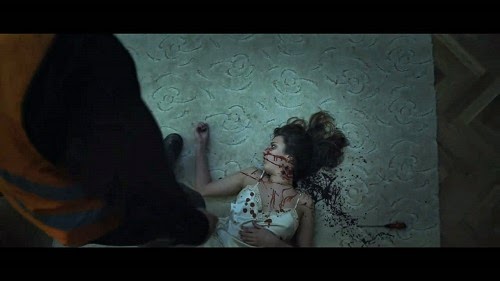 |
| "Woman in Peril," chased by a sadistic madman, is par for the course in Karapetian's The Man in the Orange Jacket (2014) |
Like several of the films that I saw at the Fantasia Film Festival, Aik Karapetian's The Man in the Orange Jacket (Man in OJ) is an excellent example of squandered potential. On the whole, the film is fairly derivative of films where a sadistic killer, out of misplaced desire turned to aggression, hunts down a bunch of unlikeable people in a remote location, and dispatches them through a wide selection of weapons/tools. If Karapetian is attempting to craft a story where we are not sympathetic towards the victims or the perpetrator, he succeeds. Yet the film has some significant moments that suggest that he's trying for something more complex and powerful--especially in regards to Eastern European class tensions.
 |
| The camera tracks our killer as he jogs on the property |
Here is where the film works: the cinematography in the Man in OJ is simply stunning, and the multiple tracking shots in the beginning of the film as it follows the man (Maxim Lazarev) leave his harbor job, travel to his boss's home, kill both the big wig and his younger wife, and then proceed to live "large" in the mansion he has invaded--well, these images are gorgeous. Karapetian masterfully manipulates the space of the mansion, and his opening and closing of the doors that divide this space increases the film's tensions exponentially. Shadows and light create a misty, grey netherworld where what is real and fantasy becomes more and more unclear.
 |
| The Man in OJ lounges in his new-found solarium |
The film also cleverly explores what it might be like to live like "the haves," when all one has known is what it's like to "have not." The man initially struggles with his new luxuries. He wears his male victim's clothes (even though they are not REMOTELY the same size), he lounges in his robe, he smokes his cigars (and hacks violently). The man goes out to dinner, and gorges on rich food that he has no idea how to eat (when all else fails, use your fingers). He then proceeds to get violently ill, and tries to recuperate in a bubble bath. He's not even good at hiring prostitutes. If I'm being generous, I would say that the film tries to critique the fantasy of affluent masculinity, suggesting that money and power are not easily obtained through violent class overthrow. At the same time, does the film imply that wealth's pleasures are illusory, or that one just really needs to be "born to it?"
 |
| The required half-naked dead girl, snuffed out after a long chase scene |
Most of the film's deeper questions fall flat because of the seemingly requisite amount of gendered sexual violence on display. This particular focus undermines any class critique, as the film frequently devolves into a "boogeyman" with a weapon chase narrative. The film's kills are straight out of the "Carol Clover guide to slasher films," with the male character dispatched with one blow, and with the women gratuitously clad and on the run from an almost supernaturally empowered killer. True, the man (in OJ) is shown to be both dis-empowered and riddled by guilt over his deeds, but that part of the film MAKES NO DAMN SENSE unless one chalks up the whole thing to fantasies nestled in his deranged mind. Major cop-out.
I initially was hoping that the film was transforming into a circular pattern, where another Man in OJ shows up, and, thinking the first man (in OJ) is the boss (who recently laid off thousands of people who work at the harbor), he goes all homicidal on him. So the man who initially INVADES the home gets his home invaded, and so on, and so on, infinity. (I think these time travel, mind fu** films are starting to infect my brain). See, here is where the film had some real potential! Yeah, but that narrative does not happen. Instead, the man seems to have a lot of misplaced, unmotivated guilt (which undermines all his previous actions), and then out of nowhere there's a really dumb Final Girl twist. Really dumb. Thankfully, the film clocks in at 71 minutes, so it's over pretty quickly. I wouldn't say that it's not worth seeing for some of its visual inventiveness, but ultimately that The Man in the Orange Jacket disappoints.